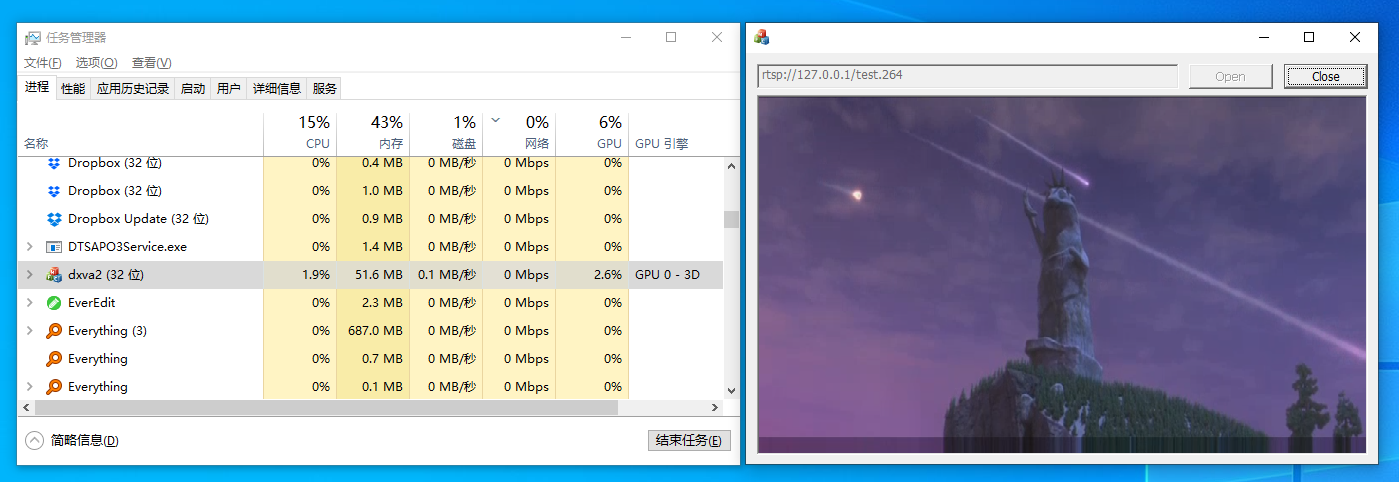使用 FFmpeg 播放高分辨率视频时,画面渲染效率是影响性能的主要原因,好在 FFmpeg 提供了各种硬件解码 / 加速的方案,可以极大的降低系统负载。
在 Windows 平台下常用硬件加速方案 dxva2。
网上已经有了一些使用 FFmpeg 实现 dxva2 硬件加速的文章,一般是通过手动配置 dxva2 解码器实现的(ffmpeg_dxva2)。
实际上现在 FFmpeg 可以通过搜索解码器的方式指定 dxva2 加速,本文就对这种方式进行说明。
查找、初始化硬件解码器 1 2 3 4 5 6 7 8 9 10 11 12 13 14 15 16 17 18 19 20 21 22 23 24 25 26 27 28 29 30 31 32 33 34 35 36 37 38 39 40 41 42 43 44 45 46 47 48 49 50 51 52 std::string dec = "dxva2"; AVHWDeviceType device_type = av_hwdevice_find_type_by_name(dec.c_str()); if (device_type == AV_HWDEVICE_TYPE_NONE) { LOG(INFO) << dec << " is not supported, available devices are : "; while ((device_type = av_hwdevice_iterate_types(device_type)) != AV_HWDEVICE_TYPE_NONE) { LOG(INFO) << av_hwdevice_get_type_name(device_type); } throw std::runtime_error("find hwdevice failed"); } for (int i = 0;; i++) { // 检查硬件加速器是否支持当前视频流 const AVCodecHWConfig * config = avcodec_get_hw_config(codec, i); if (!config) { LOG(INFO) << codec->name << " does not support device " << av_hwdevice_get_type_name(device_type); throw std::runtime_error("get hwdevice config failed"); } //找到硬件加速器支持的的颜色空间 if (config->methods & AV_CODEC_HW_CONFIG_METHOD_HW_DEVICE_CTX && config->device_type == device_type) { m_hw_pix_fmt = config->pix_fmt; break; } } // 解码器上下文 video_codec_ctx = avcodec_alloc_context3(codec); avcodec_parameters_to_context(video_codec_ctx, in_video_stream->codecpar); av_opt_set_int(video_codec_ctx, "refcounted_frames", 1, 0); video_codec_ctx->thread_count = 1; video_codec_ctx->opaque = this; video_codec_ctx->get_format = get_hw_format; if (hw_decoder_init(video_codec_ctx, device_type) < 0) { throw std::runtime_error("init hwdecoder failed"); } if (avcodec_open2(video_codec_ctx, codec, NULL) < 0) { avformat_close_input(&format_context); throw std::runtime_error("init decoder failed"); }
1 2 3 4 5 6 7 8 9 10 11 12 13 14 static AVPixelFormat get_hw_format(AVCodecContext * s, const AVPixelFormat *pix_fmts) { RtspThread * rtsp_thread = (RtspThread *)s->opaque; const enum AVPixelFormat *p; for (p = pix_fmts; *p != -1; p++) { if (*p == rtsp_thread->m_hw_pix_fmt) { return *p; } } return AV_PIX_FMT_NONE; }
hw_decoder_init 1 2 3 4 5 6 7 8 9 10 11 12 13 14 15 16 17 18 static int hw_decoder_init(AVCodecContext * ctx, const AVHWDeviceType type) { int err = 0; RtspThread * rtsp_thread = (RtspThread *)ctx->opaque; AVDictionary * options = NULL; av_dict_set_int(&options, "debug", 1, 0); if ((err = av_hwdevice_ctx_create(&rtsp_thread->m_hw_device_ctx, type, NULL, options, 0)) < 0) { LOG(INFO) << "Failed to create specified HW device"; return err; } ctx->hw_device_ctx = av_buffer_ref(rtsp_thread->m_hw_device_ctx); return err; }
以上是初始化 dxva2 硬件加速器的代码
通过 dxva2 解码得到的 AVFrame 的 format 为 AV_PIX_FMT_DXVA2_VLD 类型,视频画面保存在 frame->data[3] 中,是 IDirect3DSurface9 指针类型
接下来的问题是如何将其渲染到窗口中
通过分析源码可以得知,FFmpeg 将 D3D 相关信息存入了 AVCodecContext 中,通过以下方式获取:
1 2 3 4 AVHWDeviceContext * device_ctx = (AVHWDeviceContext*)video_codec_ctx->hw_device_ctx->data; DXVA2DevicePriv * priv = (DXVA2DevicePriv *)device_ctx->user_opaque; IDirect3DDevice9 * d3d9device = priv->d3d9device;
拿到 IDirect3DDevice9 以后就能通过 StretchRect 将 IDirect3DSurface9 渲染到窗口中了
1 2 3 4 5 6 7 8 9 IDirect3DSurface9 * surface = (IDirect3DSurface9 *)frame->data[3]; IDirect3DSurface9 * back = NULL; d3d9device->BeginScene(); d3d9device->GetBackBuffer(0, 0, D3DBACKBUFFER_TYPE_MONO, &back); d3d9device->StretchRect(surface, NULL, back, NULL, D3DTEXF_LINEAR); d3d9device->EndScene(); d3d9device->Present(NULL, NULL, m_hwnd, NULL); back->Release();
经过测试,CPU 压力的确大大降低了
